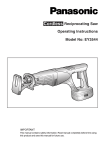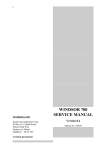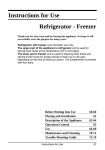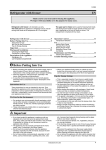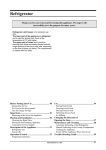Download Danby D9504S Owner`s manual
Transcript
OWNER'S MANUAL INSTRUCCIÓNES PARA EL USO NOTICE D’UTILISATION Model • Modelo • Modèle D9504S CAUTION: Read and follow all safety rules and operating instructions before first use of this product. ATENCIÓN: Antes de que usáis primera vez el aparato tienes que leer y considerar todas las recomendaciónes de seguridad y todas las instrucciónes para el uso. ATTENTION Avant la première mise en service de l’appareil, lisez attentivement les instructions techniques et nos conseils de sécurité. Danby Products Limited, PO Box 1778, Guelph, Ontario, Canada N1H 6Z9 Danby Products Inc., PO Box 669, Findlay, Ohio, USA 45839-0669 D9504/08-01 2 Instructions for Use Refrigerator with freezer Thank you for your trust and for buying this Danby appliance. We hope it will successfully serve requirements for many years. Refrigerator with freezer is for domestic use only. The lower part of this appliance is a refrigerator used for storing fresh foods at temperatures of 0°C and higher. The upper part is a freezer used for freezing fresh foods and storing frozen foods for longer periods of time (up to one year, depending on the kind of foods you store). The compartment is marked with four stars. Refrigerator with freezer................................3 Before Putting Into Use...................................4 Instructions for Use We Care for the Environment Tips for Energy Savings Important ..........................................................5 Disposing of Worn Out Appliances Placing and Installation..................................5 Choosing the Right Place Installation WARNING Grounding Instructions Connection to Power Supply Operation Control .......................................... 8 Temperature Selection Use..................................................................... 9 Storing Fresh Foods Freezing Fresh Foods Storing Frozen Foods Defrosting Frozen Food Ice Making Maintenance and Cleaning ......................... 11 Cleaning the Appliance Trouble-Shooting Guide.............................. 12 Description of the Appliance..........................6 Refrigerator (A) Low Temperature Compartment (B) Instructions for Use 3 Before Putting Into Use • Before connecting the appliance to electrical power supply, leave it stand for about 2 hours, which will reduce the possibility of malfunctions in the cooling system due to transport handling. • Clean the appliance, and be thorough, especially in the interior (See Cleaning and Maintenance). • In case the interior accessories are not correctly placed, rearrange them as described in chapter "Description of the Appliance". • The condenser on the rear wall should be always clean, free of dust or any impurities. • Always consider instructions stated in sections Positioning and Energy Saving Tips, otherwise the energy consumption is substantially higher. Instructions for Use These instructions for use are intended for the user. They describe the appliance and correct operating procedures for safe use. SAVE THESE INSTRUCTIONS: We Care for the Environment • Our products use environmentally friendly packaging, which can be either recycled or disposed of in an environmentally friendly manner. To this end, individual packaging materials are clearly marked. • These instructions are printed either on recycled paper or chlorine free bleached paper. • When your appliance finally wears out, please try not to burden the environment with it; call your nearest authorized service agent. (See Disposing of the Worn Out Appliance) Tips for Energy Savings • Try not to open the door too often, especially when the weather is hot and humid. Once you open the door, close it as soon as possible. This is especially important if you have an upright model. • Every now and then check if the appliance is sufficiently ventilated (adequate air circulation behind the appliance). • Set thermostat from higher to lower settings as soon as possible (depends on how loaded the appliance is, ambient temperature etc). • Before loading the appliance with packages of fresh foods, make sure they are cooled to ambient temperature. (excluding soup) • Ice and frost layers increase energy consumption, so clean the appliance as soon as the frost layer is 3-5 mm thick. • If the gasket is damaged or the door seal is poor, energy consumption is substantially higher. To restore efficiency, replace the gasket. 4 Instructions for Use Important • If you have bought this appliance to replace an old one equipped with a door lock that cannot be opened from the inside (lock, bolt), make sure that the lock is removed, disabled or destroyed before discarding. This will make it impossible for children to accidentally lock themselves inside the appliance and suffocate. • The appliance must be properly connected to an electrical power supply. (see: Connection to Power Supply). • If the food has a strange smell or color, throw it away, because it is very likely that it is spoiled and therefore dangerous to consume. • Always disconnect the appliance from the power supply before cleaning the appliance, replacing the light bulb and /or attempting repairs. WARNING: repairs should be performed by qualified service personnel only. • Do not defrost the appliance with other electric appliances (for example a hair dryer) and never attempt to scrape/remove ice/frost with sharp objects. Use only enclosed tools or tools recommended by the manufacturer. • For the sake of environment protection - be careful not to damage the rear wall of the appliance (i.e. the condenser unit or related tubing - when moving the appliance) or any part of the refrigerating system inside the appliance. • The refrigerating system of the appliance is filled with refrigerant and oil, so when the appliance is damaged, handle it with care and dispose of it in compliance with environmental protection safeguards. (See We Care for the Environment). • The rating plate containing Model No/Serial No and other technical data specific to this unit, is located either inside the appliance or outside on the rear wall. substances which should be separately treated and processed. Call your nearest authorized service agent or specialized servicing center. If you are unable to locate one, contact your local authorities or your distributor. Be careful not to damage the tubes on the rear wall of the appliance (danger of pollution). Disposing of Worn Out Appliances • When your appliance finally wears out, dispose of it in a safe and harmless manner. If the appliance is equipped with a door lock that cannot be opened from the inside (lock, bolt), make sure that the lock is removed, disabled or destroyed before being discarded. This will make it impossible for children to accidentally lock themselves inside the appliance and suffocate. • The refrigerating system of the appliance is filled with refrigerant and insulating Placing and Installation Instructions for Use 5 Choosing the Right Place Place the appliance in a dry and regularly ventilated room. Allowed ambient temperature depends on the model (class) of the appliance and is stated on the rating plate of the appliance. Never place the appliance near heat emitting devices (e.g. cooker, radiator, water heater or similar devices) and do not expose it to direct sunlight. Class SN (sub-normal) N (normal) ST (sub-tropical) T (tropical) The appliance should be positioned at least 3 cm away from electric or gas cooking appliances and at least 30 cm away from oil or coal fired stoves. If this is not possible, use an appropriate insulation barrier. Behind the appliance there should be free space at least 200 cm_ wide and above the appliance kitchen units (cupboards) should be at least 5 cm away from the appliance in order to assure adequate ventilation of the condenser unit. Ambient temperature from + 10°C to + 32°C from + 16°C to + 32°C from + 18°C to + 38°C from + 18°C to + 43°C WARNING Installation • Place the appliance firmly on a solid base. Some appliances have adjustable feet on the front side; use them to level the appliance. Instructions pertaining to the risk of fire, electric shock, or injury to persons. Grounding Instructions • Two spacers attached to the appliance must be fitted onto the upper edge of the condenser, thus preventing the appliance from being installed too close to the wall. Spacers are manufactured for all-purpose function depending on the distance of the condenser from the wall. Therefore turn spacers correspondingly and fix them to the appliance. For your personal safety, this appliance must be grounded. In the event of a malfunction or breakdown, grounding will reduce the risk of electric shock by providing a path of least resistance for electric current. This appliance is equipped with a power cord having an equipment grounding conductor and grounding plug. The plug must be plugged into an appropriate wall outlet that is installed and grounded in accordance with all existing local codes and ordinances. Consult a qualified electrician or seviceman if the grounding instructions are not clearly understood, or if doubt exist as to whether the appliance is properly grounded. Connection to Power Supply Connect the appliance power cord and plug to a properly grounded wall outlet. The required nominal voltage and frequency are indicated on the rating plate (inside the unit or on the exterior rear wall of the unit) This appliance resist temporary voltage tolerance up to –12 to +10%. Description of the Appliance 6 Instructions for Use Refrigerator (A) Refrigerator is used for storing fresh foods for few days. Low Temperature Compartment (B) Low temperature compartment is used for storing frozen foods. (1) Wire Shelves (4) (the number of shelves depends on model) Shelf can be optionally placed on the guides inside the appliance. It is protected against being pulled out accidentally. If you want to remove a shelf, slightly lift up the back part and pull it out. Perishable foods should be stored towards the back/rear of the shelves. i.e. the coldest part of the shelf. (2) Defrost Water Outlet The interior of the refrigerator is cooled with cooling plate incorporated in the rear wall. Under the plate there is a channel and an outlet for defrost water. Regularly check the defrost water outlet and the drain channel for blockage. They should always be kept free and clean of food particles. Instructions for Use 7 If the drain outlet does become clogged, use a plastic straw to clean it. (3) Fruit and Vegetable Crisper The crisper drawer is on the bottom of the appliance under the glass shelf. It provides adequate humidity which has a more favourable effect on fruits and vegetables. (less dehydration). Door Liner The door liner consists of various shelves or holders used for storing eggs, cheese, butter and yogurt as well as other smaller packages, tubes, cans etc. The lower shelf is used for storing bottles. Illumination in the Interior of the Refrigerator The light for illuminating the interior of the refrigerator is on, when the door is opened, off when the door is closed. Operation Control The temperature of the refrigerator is controlled by setting thermostat knob, (upper right side of the cabinet) to a desired setting. 8 Turn the knob from STOP (0) position towards 7 and backwards. Instructions for Use Temperature Selection • Higher settings on the knob (towards 7) mean lower temperatures (colder) in all compartments of the appliance. Temperature in the interior of the appliance may even drop below 0°C / 32°F. Higher settings should be used only in case higher temperature is recommended or required. When the ambient temperature is normal, we recommend medium setting. (between 3~4) • Changes in ambient room temperature will affect internal refrigerator temperatures. (choose correct setting of the thermostat knob). • In STOP (0) position the appliance does not operate (the cooling system is switched off), yet power supply is not interrupted (the light is on, when you open the refrigerator door). • Temperature in the refrigerator and in low temperature compartment also depends on how often you open the door. Use Storing Fresh Foods Proper use of the appliance, adequately packed food, correct temperature and taking into account hygienic precautions will substantially influence the quality of the food stored. • Foods to be stored in the refrigerator should be properly packed as to prevent mixing various moisture degrees and odors (in polyethylene bags or sheet, aluminium foil, wax paper, or stored in covered containers or bottles). • Before storing food in the refrigerator, remove the excessive packaging (like yoghurt in multi-package). • Pack systematically and make sure that foodstuffs do not touch each other (various odours may mix). Assure adequate air circulation around packages. • Never store inflammable, volatile or explosive substances. • Beverages with high alcohol percentage shall be stored in tightly sealed bottles in vertical position. • Food should not touch the rear wall of the refrigerator! • Foods should be cooled down before storing. • Crispy and delicate foods should be stored in the coldest parts of the refrigerator compartment. • Try not to open the door too often. • Set the thermostat to the setting where lowest temperatures are reached. Set the thermostat gradually as to avoid freezing of the foods. Use a thermometer and measure the temperature in the individual compartments. Place the thermostat in a glass vessel filled with water. Temperature readings are most reliable a few hours after steady state is reached. • Some organic solutions like volatile oils in lemon and orange peel, acid in butter etc. can cause damage when in contact with plastic surfaces or gaskets for long periods of time. • Unpleasant odor inside the refrigerator is a sign that something is wrong with foods or that your refrigerator needs cleaning. Unpleasant odor can be eliminated or reduced by washing the interior of the refrigerator with a mild solution of water and vinegar. We also recommend using activated carbon filters to clean the air or to neutralize odors. • If you planning a long journey, make sure to remove perishable articles of food out of the appliance before you leave. Fresh Food Storage Time in the Refrigerator Fresh Food Storage Time in the Butter RefrigeratorArtic Eggs le of food 1 + + 2 + + 3 + + 4 + + 5 + + Storage time (days) 6 7 8 9 10 + + = = = + + + + + Instructions for Use 11 = = 12 = = 13 14 = = 9 Meat: fresh uncut chopped smoked Fish Marinade Root Cheese Sweets Fruit Prepared dishes + + + + + + + + + + + = + = + + + + + + = + + + + + + + + = = = = + + + = = = + + + = = = + + = = = + + = = = + + = + + = + = = + = = = = = = = = = = = = = = = = = = Legend: + recommended storage time = possible storage time Freezing Fresh Foods Proper use of the appliance, adequately packed food, correct temperature and taking into account hygienic precautions will substantially influence the quality of freezing the food or storing of the frozen foodstuffs. • Carefully select food you intend to freeze; it should be of adequate quality and suitable for freezing. • Use correct packaging and wrap it right. − The packaging should be air tight and shouldn't leak since this could cause substantial vitamin loss and dehydration of foods. − Foils and bags should be soft enough to tightly wrap around the foods. • Mark packages with following data: kind and amount of foods and the date of loading. • It is most important that the food is frozen as quickly as possible. Therefore we recommend the size of the package not to be too large and to be cooled before loading into the freezer. • The amount of fresh foods that can be loaded in the freezer within 24 hours is indicated on the rating plate (freezing capacity). If the loaded amount is too large, the quality of freezing is reduced which affects the quality of frozen foods. Freezing Procedure • The next time you want to freeze fresh foods, repeat the freezing procedure and be careful that packages with fresh foods do not touch frozen packages. • For freezing smaller amount of foods (up to 1 kg) there is no need to change the thermostat setting (see Temperature Selection). Storing Frozen Foods Frozen foods can be stored on the bottom of the freezer compartment. Commercially Frozen Foods The storage time and the recommended temperature for storing commercially frozen foods are indicated on the packaging. For storing and using consider the manufacturer's instruction. When shopping, be careful and choose only adequately packed foods provided with complete data and stored in freezers where the temperature is not higher than -18°C (-0,4°F). Do not buy packages of food covered with frost layer. This indicates that the package was thawed before at least once. Be careful that packages don't start to thaw, as the temperature raise reduces the quality of foods. • 24 hours before loading the freezer with fresh foods to be frozen, set the thermostat to position 5-7. Put packages on the shelf and let them freeze. Some 24 hours after loading the packages of fresh foods, reset the thermostat, if necessary, to operating temperature (See Temperature Selection). Approximate Storage Time for Frozen Foods Food 1 Vegetable Fruit 10 2 3 4 Storage time (in months) 5 6 7 8 + Instructions for Use 9 + 10 + + 11 12 + + Bread, pastries Milk Ready-made meals Meat: Beef Veal Pork Poultry Game Minced meat Smoked sausages Fish: lean fat Offal + + + + + + + + + + + + + + + + + + + + + + + Defrosting Frozen Food Partially thawed or defrosted foods should be used as soon as possible. Cold air preserves the food but it does not destroy microorganisms which rapidly activate after defrosting and make foods perishable. Partial defrosting reduces the nutritional value of foods, especially of fruits, vegetables and ready-made meals. Ice Making Recommended thermostat position for ice making is on the middle setting. Fill two thirds of the ice tray with cold water or any other liquid convenient for freezing. Time required for the ice to form, largely depends on ambient temperature, thermostat setting and on how often you open the door. It usually takes 2-6 hours (depends on which model of refrigerator you have). With smaller refrigerators we recommend you make a stock of ice cubes (store them in a separate plastic box). The easiest way to empty the ice tray is to turn the tray around, pour it with cold water and slightly twist it (bend it). Maintenance and Cleaning Automatic Defrosting of the Refrigerator There is no need to defrost the refrigerator, because ice depositing on the inner back wall is defrosted automatically. Instructions for Use 11 Ice build-up on the inner back wall during the compressor operation; will (when the compressor has cycled off) defrost automatically. Defrost water collects inside the drain trough passing through the drain outlet in the inner back wall into a drain pan situated above the compressor, from where it evaporates. • Clean the drain pan on the refrigerator compressor. Do not remove the drain pan! Manual Defrosting of the Low Temperature Compartment When the frost and ice layer in the low temperature compartment is 3-5 mm thick, you should clean the freezer. • Turn the thermostat knob to STOP (0) position and disconnect the power supply. Empty the compartment and take care that the packages remain frozen. • Use a suitable cloth to dry the defrost water collected during defrosting on the bottom of the low temperature compartment. Leave the door of the compartment open to accelerate defrosting. • Avoid using defrosting sprays, as they may cause damage to the plastic parts and may be hazardous to health. After cleaning, connect the appliance to power supply and reload the packages. Cleaning the Appliance Disconnect the power supply before cleaning the appliance. Do not use coarse or aggressive cleaning agents as you can damage the surface. • Clean the exterior with water and detergent. Varnished surfaces are cleaned with soft cloth and an alcohol based cleaning agent (for example glass cleaners). You may also use alcohol (ethanol or isoprophylic alcohol). The application of abrasive and specially aggressive cleaners, such as the stainless steel cleaners, is not appropriate for the cleaning of plastic and coated parts. • Remove the detachable accesories in the interior of the appliance and clean it with water and liquid detergent. Plastic parts cannot be washed in dishwashers. • Wash the interior of the appliance with lukewarm water, in which you added one or two spoonfuls of vinegar. • Every now and then wipe the condenser on the rear wall. Use soft non-metal brush or vacuum cleaner. Switch Off the Appliance When Not In Use If you do not intend to use the appliance for long time periods, (vacations) set the thermostat knob to the STOP (0) position, disconnect the power supply, take out the foods and defrost and clean the appliance. Leave the door slightly open. Trouble-Shooting Guide Sometimes you may to come across minor problems that in most cases do not require a service call and can be easily eliminated. The problem may have resulted from improper handling and/or installation of the appliance. Please refer to the below trouble-shooting 12 guide to assist you in identifying the possible cause and solution to your problem. Should the problem still persist after completing these checkpoints. Contact the closest authorized service agent in your area for assistance. Instructions for Use The Appliance Fails to Operate After Connecting to Electrical Power Supply Noise • Check the power cord is properly connected. • Check the power supply in the electrical outlet. (blown fuse / circuit breaker) • Make sure the appliance is switched on. (thermostat knob in operating position) Continuous Operation of the Cooling System • The door is frequently opened or left open for too long. • The door is not properly closed (the door may sag, the gasket may be polluted or damaged). • Perhaps you have overloaded the appliance with fresh foods. • The reason may be inadequate ventilation of the compressor and condenser (assure adequate air circulation and wipe off the condenser). Ice Formation on the Inner Rear Wall As long as the defrost water runs to the channel and through the outlet to the drain pan on the compressor, automatic defrosting of the appliance is assured. In case the ice formation on the inner back wall is increased (3-5 mm), ice should be manually defrosted. Set the thermostat knob to STOP (0) position and leave the door open. Never use electric devices for defrosting and do not scrape the ice or frost layer with sharp objects. After defrosting is complete, turn the knob to desired position and close the refrigerator door. The cause of increased ice formation may be one of the following: − the door does not seal well (clean the gasket if it is contaminated, or replace it if it is damaged); − the door is frequently opened or left open for too long; − the food stored in the refrigerator was warm; − the food or dish is touching the inner back wall. Cooling in a refrigerating-freezing appliance is made possible by cooling the system using a compressor, which will produces certain noise levels. How noisy the appliance is depends on where it is placed, how it is used and how old the appliance is. • During the operation of the compressor the noise of liquid is heard and when the compressor is not operating, the refrigerant flow is heard. This is a normal condition and it has no influence whatsoever on the lifetime of the appliance. • After starting the appliance, the operation of the compressor and the refrigerant flow may be louder, which does not mean that something is wrong with the appliance and it has no influence on the lifetime of the appliance. Gradually the noise is reduced. • Sometimes unusual and stronger noise is heard, which is rather unusual for the appliance. This noise is often a consequence of inadequate installation. − The appliance must be level and installed on a firm solid base/floor. − It should not touch the wall or kitchen units standing next to it. − Check the accessories on the interior of the appliance, they should be placed correctly in their positions; also check, bottles, tins and other vessels are not touching each other causing rattling and/or vibrations. Bulb Replacement Before replacing the light bulb, disconnect the appliance from the power supply. Press the cover at the rear side (in the arrow 1 direction) and remove the plastic cover (in the arrow 2 direction). Replace the bulb with a new one (E14, max. 10 W). Don't forget: the old bulb does not belong to organic waste. Use proper disposal methods. Water is Leaking From the Refrigerator In case the discharge water outlet is clogged, or the defrost water drips over the channel, water leaks from the refrigerator. • Clean the clogged outlet, for example with a plastic straw. • Manually defrost the increased ice layer. See "Ice Formation on the Inner Rear Wall". Instructions for Use 13 WE RESERVE THE RIGHT TO ALTER THE SPECIFICATIONS WITH NO INFLUENCE ON THE OPERATION OF THE APPLIANCE. 14 Instructions for Use 03/01 Instructions for Use 15














